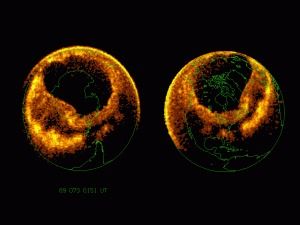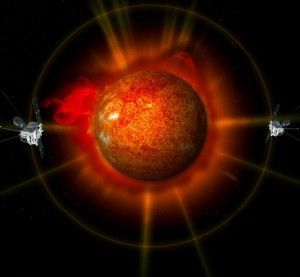When examining the delicate balance that life on Earth hangs within, it is impossible not to consider the ongoing love/hate connection between our parent star, the sun, and our uniquely terraqueous home planet.
On one hand, Earth is situated so perfectly, so ideally, inside the sun’s habitable zone, that it is impossible not to esteem our parent star with a sense of ongoing gratitude. It is, after all, the onslaught of spectral rain, the sun’s seemingly limitless output of charged particles, which provide the initial spark to all terrestrial life.
Yet on another hand, during those brief moments of solar upheaval, when highly energetic Earth-directed ejecta threaten with destruction our precipitously perched technological infrastructure, one cannot help but eye with caution the potentially calamitous distance of only 93 million miles that our entire human population resides from this unpredictable stellar inferno.
On 6 February 2011, twin solar observational spacecraft STEREO aligned at opposite ends of the sun along Earth’s orbit, and for the first time in human history, offered scientists a complete 360-degree view of the sun. Since solar observation began hundreds of years ago, humanity has had available only one side of the sun in view at any given time, as it slowly completed a rotation every 27 days. First launched in 2006, the two STEREO satellites are glittering jewels among a growing crown of heliophysics science missions that aim to better understand solar dynamics, and for the next eight years, will offer this dual-sided view of our parent star.
In addition to providing the source of all energy to our home planet Earth, the sun occasionally spews from its active regions violent bursts of energy, known as coronal mass ejections(CMEs). These fast traveling clouds of ionized gas are responsible for lovely events like the aurorae borealis and australis, but beyond a certain point have been known to overload orbiting satellites, set fire to ground-based technological infrastructure, and even usher in widespread blackouts.
CMEs are natural occurrences and as well understood as ever thanks to the emerging perspective of our sun as a dynamic star. Though humanity has known for centuries that the solar cycle follows a more/less eleven-year ebb and flow, only recently has the scientific community effectively constellated a more complete picture as to how our sun’s subtle changes effect space weather and, unfortunately, how little we can feasibly contend with this legitimate global threat.
The massive solar storm that occurred on 1 September 1859 produced aurorae that were visible as far south as Hawai’i and Cuba, with similar effects observed around the South Pole. The Earth-directed CME took all of 17 hours to make the 93 million mile trek from the corona of our sun to the Earth’s atmosphere, due to an earlier CME that had cleared a nice path for its intra-stellar journey. The one saving grace of this massive space weather event was that the North American and European telegraph system was in its delicate infancy, in place for only 15 years prior. Nevertheless, telegraph pylons threw sparks, many of them burning, and telegraph paper worldwide caught fire spontaneously.
Considering the ambitious improvements in communications lines, electrical grids, and broadband networks that have been implemented since, humanity faces the threat of space weather on uneven footing. Large CME events are known to occur around every 500 years, based on ice core samples measured for high-energy proton radiation.
The CME event on 14 March 1989 overloaded the HydroQuebec transmission lines and caused the catastrophic collapse of an entire power gird. The resulting aurorae were visible as far south as Texas and Florida. The estimated cost was totaled in the hundreds of million of dollars. A later storm in August 1989 interfered with semiconductor functionality and trading was called off on the Toronto stock exchange.

Beginning in 1995 with the launch and deployment of The Solar Heliospheric Observatory (SOHO), through 2009 with the launch of SDO, the Solar Dynamics Observatory, and finally this year, with the launch of the Glory science mission, NASA is making ambitious, thoughtful strides to gain a clearer picture of the dynamics of the sun, to offer a better means to predict space weather, and evaluate more clearly both the great benefits and grave stellar threats.
Earth-bound technology infrastructure remains vulnerable to high-energy output from the sun. However, the growing array of orbiting satellites that the best and the brightest among modern science use to continually gather data from our dynamic star will offer humanity its best chance of modeling, predicting, and perhaps some day defending against the occasional outburst from our parent star.
Written by Zachary Urbina, Founder Cozy Dark

Excellent article! As a pilot who depends on GPS I’m well aware of solar flare activity and it’s detrimental effects on our GPS infrastructure, not to mention cellphones and really any other wave-based communications networks. Maybe this is a good argument for keeping some of the old systems (HAM/AM) available as an emergency backup? Or, more likely, we will find ways to harden our systems against these effects…
OK, this isn’t particularly new or revelatory information. How about putting this information into a broader context. Like the fact that the sun varies in a number of reasonably predictable ways. There’s the ~11 year Schawbe cycle. There’s the ~22 year Hale cycle. There’s the ~87 year Gließberg cycle. There’s the ~210 year Suess cycle. There’s the ~2,300 year Hallstadt cycle. All of which affect the occurrence of solar “tantrums”.
Another interesting data point might have been to report that the most recent NASA prediction of where solar cycle 24 (the current solar cycles) was nearly 2 years late in starting and is going to peak at an averaged sunspot number of 58. This number has been revised downward steadily since 2008 when the prediction stood at 130–140. For the sake of reference, that predicted “high” is equivalent to the “high” observed during the Maunder Minimum, which occurred from around 1675 and lasted up to around 1715 The Maunder is associated with the coldest part of the Little Ice Age event which saw the Thames frozen regularly during the winters.
I don’t mean to bust your chops, but if you’re going to communicate scientific information, I do think it would help immensely that you include a little more information for your readers to learn. When you talk about the “tantrums” of our local star, it seems to me that you have some obligation to help your readers put that into focus a little more sharply, otherwise it just seems like gratuitous fear-mongering.
“In addition to providing the source of all energy to our home planet Earth…”
Oil may be stored solar energy but you forget nuclear. Once the oil’s gone, nuclear will be the main source of energy assuming we haven’t forgotten how to build the infrastructure.
You are guilty of anthropomorphic thinking. The Sun is a big hot gas ball. It has patterns defined by its physics, not by any pique toward we humans. The Sun is not a God.
Human Beings live an environment having its own rules which we must adapt to. Sun Spot cycle 24 was long delayed. It is irregular except for producing few Sun Spots. We have gone through this pattern before, look up Maunder Minimum in Google. Big solar disturbances are possible during a low Sun Spot cycle. It is foolish not to look at the big picture and compare our current cycle with previous ones. If you did, you would find that Solar Activity is low and the heat output from the Sun is below normal. This is partly responsible for the cold winters we have been experiencing since 2006.
Science does not yet understand why these events are occurring in the Sun. It could be from a series of occurrences, deep within the center, which occurred a million years ago. It takes about that long for the energy from fusion to make its way to the surface.
“On one hand, Earth is situated so perfectly, so ideally, inside the sun’s habitable zone, that it is impossible not to esteem our parent star with a sense of ongoing gratitude.”
Oh yeah. Let’s bow, even in whimsy, to an amorphous conflagration of gasses. Because that’s funny, right? I mean, really, the idea that man need bow to anything, pssssh. But let’s make sure we put the all-hands mob beat down on even considering the possibility that this infinitely perfect balance and its miraculously fine tolerances, the existence of which you at least have the intellectual honesty to concede, couldn’t possibly be anything but the random result of time on scattered atoms of matter of totally unknown provenance. And all the while secure in the confidence WE make things happen.
Ye gods and little fishes, the smug arrogance of homo scientificus…
Yes, Sardondi, and the arrogance also of the irrationally religious!
The author did not challenge your religious views here; the “gratitude” spoken of in the article is possible whether you want to believe in a Creator or not. That big chip thing on your shoulder isn’t an asteroid, is it?
“(I) do not yet understand why these events are occurring in (my wife). It could be from a series of occurrences, deep within (her) center, which occurred a million years ago.”
Why not anthropomorphize the sun? I do it to my wife all the time and she’s at LEAST as inscrutable as the sun!
One man’s physics is another man’s pique, I say.
: )
@austin simple solutions are often the best solutions.
@skip thank you for differentiating between anthropocentrism and anthropomorphism.
Thank you all for your insightful comments and ongoing vibrant discussion.
@Martin Hale: IIRC Cycle 24 did NOT start two years late; all of the stigmata (such as magnetic pole reversals and latitude of disturbances) were right on schedule. There just weren’t any sunspots…
@Austin — I work in a facility that has machines which produce CME-like effects (if only for nanoseconds at a time, with hours-long delays between “shots”)… and our biggest customers are those producing next-generation geo-sync satellite systems. They expose sub-assemblies and components to this environment, and find out how best to protect them.
We may not be perfect, but we are aware of the risks and are doing the best we can. :-)
-MJ